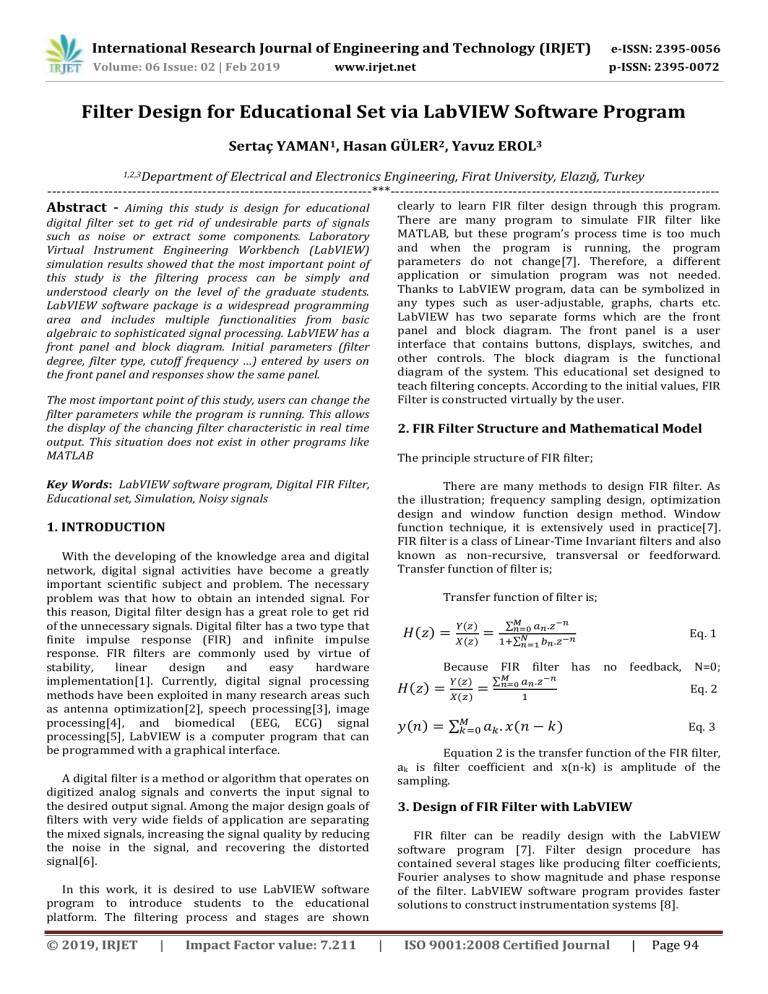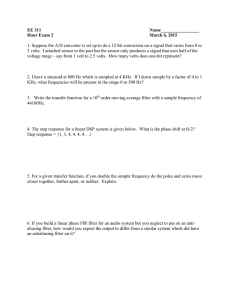IRJET-Filter Design for Educational Set Via Labview Software Program
advertisement

International Research Journal of Engineering and Technology (IRJET) e-ISSN: 2395-0056 Volume: 06 Issue: 02 | Feb 2019 p-ISSN: 2395-0072 www.irjet.net Filter Design for Educational Set via LabVIEW Software Program Sertaç YAMAN1, Hasan GÜLER2, Yavuz EROL3 1,2,3Department of Electrical and Electronics Engineering, Firat University, Elazığ, Turkey ---------------------------------------------------------------------***---------------------------------------------------------------------- Abstract - Aiming this study is design for educational clearly to learn FIR filter design through this program. There are many program to simulate FIR filter like MATLAB, but these program’s process time is too much and when the program is running, the program parameters do not change[7]. Therefore, a different application or simulation program was not needed. Thanks to LabVIEW program, data can be symbolized in any types such as user-adjustable, graphs, charts etc. LabVIEW has two separate forms which are the front panel and block diagram. The front panel is a user interface that contains buttons, displays, switches, and other controls. The block diagram is the functional diagram of the system. This educational set designed to teach filtering concepts. According to the initial values, FIR Filter is constructed virtually by the user. digital filter set to get rid of undesirable parts of signals such as noise or extract some components. Laboratory Virtual Instrument Engineering Workbench (LabVIEW) simulation results showed that the most important point of this study is the filtering process can be simply and understood clearly on the level of the graduate students. LabVIEW software package is a widespread programming area and includes multiple functionalities from basic algebraic to sophisticated signal processing. LabVIEW has a front panel and block diagram. Initial parameters (filter degree, filter type, cutoff frequency …) entered by users on the front panel and responses show the same panel. The most important point of this study, users can change the filter parameters while the program is running. This allows the display of the chancing filter characteristic in real time output. This situation does not exist in other programs like MATLAB 2. FIR Filter Structure and Mathematical Model The principle structure of FIR filter; Key Words: LabVIEW software program, Digital FIR Filter, Educational set, Simulation, Noisy signals There are many methods to design FIR filter. As the illustration; frequency sampling design, optimization design and window function design method. Window function technique, it is extensively used in practice[7]. FIR filter is a class of Linear-Time Invariant filters and also known as non-recursive, transversal or feedforward. Transfer function of filter is; 1. INTRODUCTION With the developing of the knowledge area and digital network, digital signal activities have become a greatly important scientific subject and problem. The necessary problem was that how to obtain an intended signal. For this reason, Digital filter design has a great role to get rid of the unnecessary signals. Digital filter has a two type that finite impulse response (FIR) and infinite impulse response. FIR filters are commonly used by virtue of stability, linear design and easy hardware implementation[1]. Currently, digital signal processing methods have been exploited in many research areas such as antenna optimization[2], speech processing[3], image processing[4], and biomedical (EEG, ECG) signal processing[5], LabVIEW is a computer program that can be programmed with a graphical interface. Transfer function of filter is; ( ) ( ) Impact Factor value: 7.211 ( ) ∑ Eq. 2 ( ) ∑ ( ) Eq. 3 Equation 2 is the transfer function of the FIR filter, ak is filter coefficient and x(n-k) is amplitude of the sampling. 3. Design of FIR Filter with LabVIEW FIR filter can be readily design with the LabVIEW software program [7]. Filter design procedure has contained several stages like producing filter coefficients, Fourier analyses to show magnitude and phase response of the filter. LabVIEW software program provides faster solutions to construct instrumentation systems [8]. In this work, it is desired to use LabVIEW software program to introduce students to the educational platform. The filtering process and stages are shown | Eq. 1 ∑ ( ) Because FIR filter has no feedback, N=0; A digital filter is a method or algorithm that operates on digitized analog signals and converts the input signal to the desired output signal. Among the major design goals of filters with very wide fields of application are separating the mixed signals, increasing the signal quality by reducing the noise in the signal, and recovering the distorted signal[6]. © 2019, IRJET ∑ ( ) ( ) | ISO 9001:2008 Certified Journal | Page 94 International Research Journal of Engineering and Technology (IRJET) e-ISSN: 2395-0056 Volume: 06 Issue: 02 | Feb 2019 p-ISSN: 2395-0072 www.irjet.net In FIR filter design procedure, the frequency responses are changed with the window types function, filter degrees, sampling frequency and filter types (high-pass, low-pass, band-pass band-stop) [9]. In table 1, the different filter types transfer functions have shown in below. The filter coefficients are defined the following equation. [ ] [ ] [ ] Eq. 4 h[n] is the FIR filter coefficients, w[n] is window types and n is the integer that is changed between from 0 to filter degree (N) and M=N/2. Table 1: Functions of the FIR filter coefficients [ ] Filter Type LowPass [ ] ( ( ) ( HighPass ( ( ( ( ) ( ( ( ( ) ( ( ) ) ) ) ) ) ( ) ) ( BandStop ) ) ( ( In figure 1, it is shown that band stop filter coefficients are determined with the band-stop function of Table 1. The band is an interval between two different frequencies and the band-stop filter does not transmit the signal between two specific frequencies and directly transmits the signals outside that range[10]. ) ( BandPass Figure 1. FIR Filter coefficient ) ( ( ) ) ) ) ) The filter frequency definitions used in this study are shown below, = = Figure 2. Fourier analysis, Magnitude and Phase response = The amplitude and phase responses of the band stop FIR filter are obtained by taking the Fourier analysis with the Filter coefficients that were determined in the figure1. = =High pass frequency =Low pass frequency © 2019, IRJET | Impact Factor value: 7.211 | ISO 9001:2008 Certified Journal | Page 95 International Research Journal of Engineering and Technology (IRJET) e-ISSN: 2395-0056 Volume: 06 Issue: 02 | Feb 2019 p-ISSN: 2395-0072 www.irjet.net Figure 4 represents the front panel of the LabVIEW to show the response of 25th order band-stop FIR filter. The ECG signal is applied to the inlet of the filter to indicate the operation of the filter. In figure 4, the supply frequency mixed with the ECG signal is filtered. Filter the filtration process change as long as input variable is modifying (coefficients, discrete-time input values, and filtration interval change)[11]. Low cutoff frequency and high cutoff frequency were selected for the 60 Hz frequency of the AC electricity. This frequency clearly filtered and shown in magnitude and y[n] graph which were represented in figure 4. For these changes, the program works instantly without needing to run again. 3. CONCLUSION In this study, FIR filter design was realized by using window method in LabVIEW program. The filter has been made more flexible by this program, that is, even when the program is running, the parameters can be changed and these changes can be observed in an instant. To make the program more efficient and effective for users, filter design is done with the basic commands of the LabVIEW. the ECG signal is filtered to show that the simulation program is working. In this way, filtering stages will be learned permanently. Figure 3. Filter output (convolution of h[n] and x[n]) The ECG signal was taken from http://physionet.org. Fig. 3 shows the results obtained for filter output with the convolution of the filter coefficients array (h[n]) and noisy ECG signal that was read from the text file. The steps of the fır filter design will be mentioned in this section • • • In the first step, Filter coefficients are determined by means of input conditions (filter type, order of filter, cutoff frequency etc.) Fourier analysis was performed to find the magnitude and the Phase of the FIR filter Input signal (ECG=Electrocardiography) was read from txt file and the filter coefficients and the ECG signal were convolved to filter the frequency of the AC electricity signal with the band-stop FIR filter procedure. REFERENCES 1) A. Kumar and B. Kuldeep, “Design of M-channel cosine modulated filter bank using modified Exponential window,” J. Franklin Inst., vol. 349, no. 3, pp. 1304–1315, 2012. 2) Z. Bayraktar, M. Komurcu, J. A. Bossard, and D. H. Werner, “The wind driven optimization technique and its application in electromagnetics,” IEEE Trans. Antennas Propag., vol. 61, no. 5, pp. 2745– 2757, 2013. 3) S. Padmapriya and V. Lakshmi Prabha, “Design of an efficient dual mode reconfigurable FIR filter architecture in speech signal processing,” Microprocess. Microsyst., vol. 39, no. 7, pp. 521– 528, 2015. 4) L. J. Morales-Mendoza, R. F. Vázquez-Bautista, E. Morales-Mendoza, Y. Shmaliy, and H. GamboaRosales, “A new recursive scheme of the unbiased FIR filter to image processing,” in Procedia Engineering, 2012, vol. 35, pp. 202–209. 5) M. G. Egila, M. a El-Moursy, A. E. El-Hennawy, H. a El-Simary, and A. Zaki, “FPGA-based electrocardiography (ECG) signal analysis system using least-square linear phase finite impulse response (FIR) filter,” J. Electr. Syst. Inf. Technol., vol. 3, no. 3, pp. 1–14, 2016. Figure 4. FIR Filter Front Panel © 2019, IRJET | Impact Factor value: 7.211 | ISO 9001:2008 Certified Journal | Page 96 International Research Journal of Engineering and Technology (IRJET) e-ISSN: 2395-0056 Volume: 06 Issue: 02 | Feb 2019 p-ISSN: 2395-0072 www.irjet.net 6) M. B. Joaquim and C. A. S. Lucietto, “A nearly optimum linear-phase digital FIR filters design,” Digit. Signal Process. A Rev. J., vol. 21, no. 6, pp. 690–693, 2011. 7) S. Chakraborty, “Advantages of Blackman Window over Hamming Window Method for designing FIR Filter,” Int. J. Comput. Sci. Eng. Technol., vol. 4, no. 8, pp. 1181–1189, 2013. 8) Y. Berthoumieu, E. Grivel, and M. Najim, “Finite Impulse Response Filters,” in Digital Filters Design for Signal and Image Processing, 2010, pp. 137–172. 9) E. S. Kolawole, W. H. Ali, P. Cofie, J. Fuller, C. Tolliver, and P. Obiomon, “Design and Implementation of Low-Pass, High-Pass and Band-Pass Finite Impulse Response (FIR) Filters Using FPGA,” Circuits Syst., vol. 6, no. 2, pp. 30–48, 2015. 10) A. Widmann, E. Schröger, and B. Maess, “Digital filter design for electrophysiological data - a practical approach,” J. Neurosci. Methods, pp. 1– 16, 2014. 11) A. S. Morris and R. Langari, “Data Acquisition with LabVIEW,” in Measurement and Instrumentation, 2012, pp. 115–133. © 2019, IRJET | Impact Factor value: 7.211 | ISO 9001:2008 Certified Journal | Page 97

